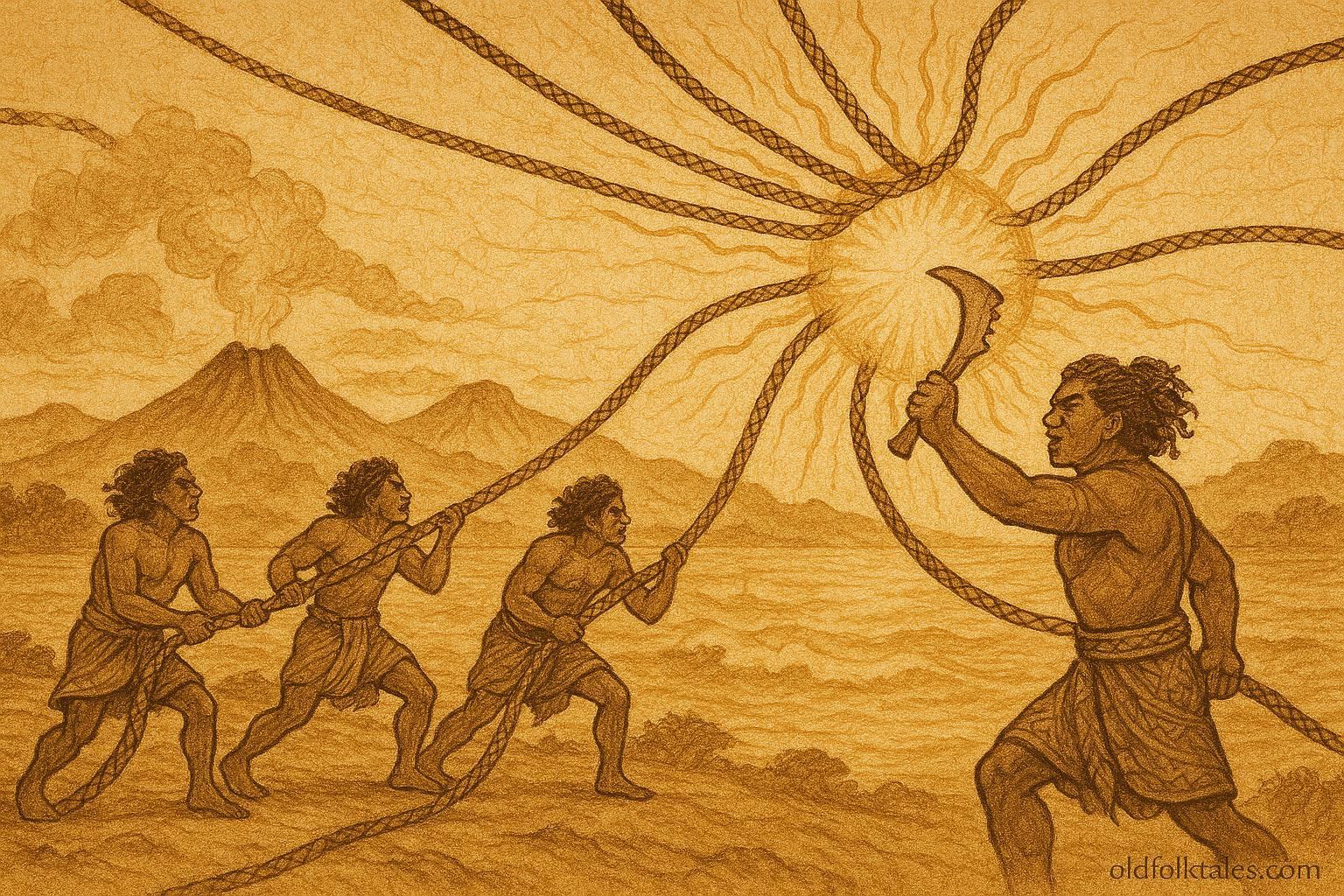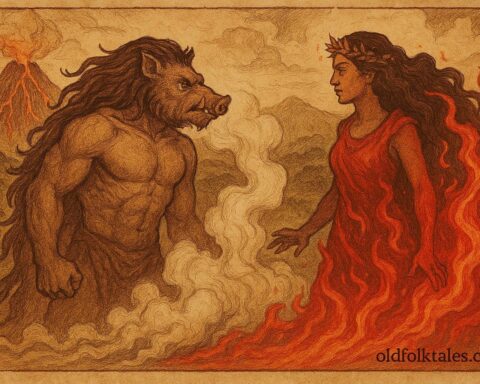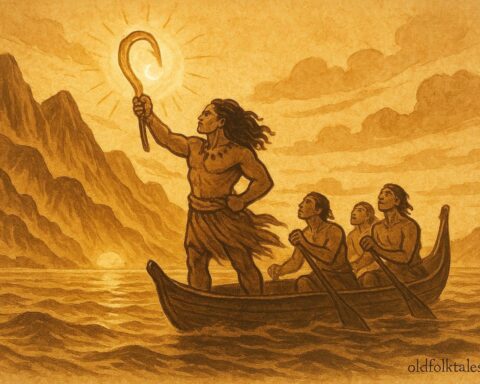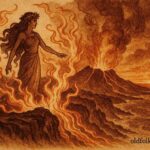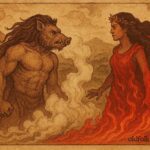Long ago, when the world was still young and men and gods walked close together, the people of Aotearoa lived in constant struggle with time. The days were too short; the Sun sped across the sky like a fiery bird in flight. Men could not finish weaving their nets or tilling the earth before darkness fell. Women found their fires still cold and their food half-cooked when night returned too soon.
The demigod Māui-tikitiki-a-Taranga, known for his cleverness and daring, watched these troubles with concern. He had already fished great islands from the sea and performed deeds that astonished both mortals and spirits. Yet he saw that the Sun’s reckless haste caused suffering for all living things.
Sail through the legends of brave navigators, ocean spirits, and island gods
One evening, as the crimson light sank behind the mountains, Māui gathered his brothers. “Look,” he said, pointing toward the sky. “Before we have eaten, before the day’s work is done, the Sun has already fled. It races too quickly, and we are left in darkness.”
His brothers agreed but doubted that anything could be done. “How can a handful of men change the path of the Sun?” one asked.
But Māui’s eyes glowed with determination. “The Sun is strong,” he said, “yet not invincible. We will go to its rising place, and there we will catch it. We will make it promise to slow its flight, so that our people may live in peace.”
The Plan to Catch the Sun
The brothers hesitated, but they trusted Māui’s wisdom. Following his command, they began gathering long strands of flax and twisting them into thick, enchanted ropes. Māui wove secret spells into the fibers, whispering ancient words of binding learned from his ancestors. For days they worked in silence, weaving under the moonlight until their hands were raw and their hearts steady with purpose.
When the ropes were finished, Māui led his brothers eastward through forests and valleys, across rushing rivers, and over the volcanic plains that trembled underfoot. The journey was long and harsh. At night they slept in fern hollows; by day they walked until their shadows vanished under the blazing sun they sought to subdue.
At last, they reached the edge of the world where the Sun’s pit lay, the great hollow from which the fiery orb rose each morning. Smoke and heat shimmered over the blackened stones. The brothers hid behind great slabs of rock, hearts pounding like the drums of war.
The Ambush at Dawn
Māui spoke softly: “When the Sun appears, throw the ropes over it. Hold fast, no matter how fiercely it struggles. If you let go, we are lost.”
He then took up the enchanted jawbone of his ancestor, polished white and gleaming like the moon. This sacred weapon, gifted from the spirits, had served him in many deeds of courage.
As the first light glowed over the horizon, the Sun burst forth, blinding and fierce, its flames shooting like spears across the sky. With a cry, Māui and his brothers cast their ropes. The cords flew true, encircling the Sun’s blazing arms.
The Sun roared, shaking the mountains and searing the air. “Who dares bind me, the giver of light?” it thundered. The brothers strained, their skin blistering from the heat, but they did not release their hold.
Māui stepped forward, raising the enchanted jawbone. “It is I, Māui of the many deeds! You race too fast, O Sun, and your haste brings misery to the world. You shall learn to move with mercy!”
The Struggle
The Sun thrashed violently, flinging sparks like arrows, but Māui and his brothers pulled tighter, forcing its radiance close to the earth. The light became unbearable; stones melted beneath their feet, and smoke rose from the scorched ground.
Again the Sun bellowed, “Release me, lest you burn with me!”
But Māui struck it with the jawbone, each blow ringing with thunder. The Sun’s flames dimmed, and its strength waned. At last, weakened and trembling, the great orb cried out, “Enough! I yield! Spare me, and I shall travel more slowly across the heavens. I will lengthen the days so your people may live and work in peace.”
Māui lowered his weapon. “Swear it by the light that gives life to all things,” he commanded.
“I swear,” said the Sun, “by the light of my being and by the warmth of my fire.”
And from that moment, the Sun rose gently into the sky, moving at a pace that gave balance to night and day.
Harmony Restored
When Māui and his brothers returned home, the people rejoiced. They could now fish the seas, build their homes, and plant their crops before darkness came. The earth thrived under the fair rhythm of time.
Elders sang praises of Māui’s wisdom and courage. “He tamed the Sun for the good of all,” they said, “and his name shall never fade.”
And so it was that the short, harsh days of old became the balanced days of the world we know. To this day, when the morning sun rises gently over Aotearoa, the Māori remember Māui, the trickster, the hero, the bringer of balance.
Discover the adventures of Māui, Pele, and Tangaloa in the timeless Polynesian oral tradition
Moral Lesson
This legend teaches that intelligence and unity can overcome even the most powerful forces. Māui’s courage and his brothers’ cooperation show that balance in nature comes not through destruction, but through wisdom, patience, and harmony with the world’s rhythms.
Knowledge Check (Q&A)
- Why did Māui decide to capture the Sun?
Because the Sun moved too quickly, making days too short for people to work and live peacefully. - How did Māui and his brothers prepare for their quest?
They wove enchanted flax ropes and traveled east to the Sun’s rising place. - What weapon did Māui use against the Sun?
He wielded the magical jawbone of his ancestor, a sacred tool of strength and mana. - How did the brothers trap the Sun?
They cast their ropes over it at dawn and held tight despite its furious struggle. - What promise did the Sun make after being captured?
The Sun vowed to travel more slowly across the sky, bringing longer, balanced days. - What is the main lesson of the story?
Through courage, cooperation, and wisdom, humans can achieve harmony with the forces of nature.
Source: Adapted from Polynesian Mythology and Ancient Traditional History of the New Zealand Race by Sir George Grey (1855).
Cultural Origin: Māori (Aotearoa/New Zealand)
